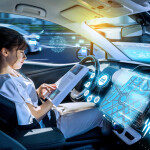Understanding Autonomous Vehicles
Autonomous vehicles, also known as self-driving cars or driverless vehicles, are vehicles equipped with advanced sensors, artificial intelligence, and machine learning algorithms that enable them to navigate and operate without human intervention. These vehicles can perceive their surroundings, make decisions, and interact with the environment using a combination of technologies such as cameras, lidar, radar, and GPS.
Benefits of Autonomous Vehicles
Autonomous vehicles offer numerous benefits that can transform the way we travel and commute. Firstly, they have the potential to significantly reduce road accidents caused by human error, as the advanced sensors and algorithms are designed to make split-second decisions to avoid collisions. Additionally, self-driving cars can optimize traffic flow, reducing congestion and commuting time. They can also provide accessible transportation options for people with disabilities and the elderly, enhancing their mobility and independence.
Challenges Faced by Autonomous Vehicles
While the promise of autonomous vehicles is enticing, there are several challenges that need to be overcome for their widespread adoption. One of the primary concerns is safety and security. Ensuring that self-driving cars operate reliably and securely is crucial to prevent accidents and protect against cyber threats. Additionally, the legal and regulatory framework surrounding autonomous vehicles needs to be established to address liability issues and determine responsibility in case of accidents.
Safety and Security Concerns
Safety and security are paramount when it comes to autonomous vehicles. The technology powering self-driving cars must be able to handle unpredictable situations and make ethical decisions on the road. There is a need for robust testing and validation procedures to ensure the safety of autonomous vehicles before they are deployed on public roads. Furthermore, cybersecurity measures must be implemented to safeguard against potential hacking attempts that could compromise the vehicles' control systems.
Legal and Regulatory Implications
The introduction of autonomous vehicles raises complex legal and regulatory questions. Determining liability in case of accidents involving self-driving cars is a significant challenge. Should the responsibility lie with the vehicle manufacturer, the software developer, or the human occupant? Additionally, regulations need to be established to ensure the safety and privacy of passengers and pedestrians. Policymakers must work collaboratively with industry stakeholders to create a comprehensive legal framework that addresses these concerns.
Infrastructure and Technological Advancements
The successful integration of autonomous vehicles requires significant advancements in infrastructure and technology. To support self-driving cars, roads and transportation systems need to be upgraded with intelligent infrastructure, including dedicated lanes, advanced traffic management systems, and robust communication networks. Furthermore, ongoing research and development are essential to improve the capabilities of autonomous vehicles, enhancing their ability to operate in various weather conditions and complex urban environments.
Economic and Societal Impact
The rise of autonomous vehicles will have far-reaching economic and societal implications. While self-driving cars can potentially improve productivity and reduce transportation costs, they may also disrupt certain industries and lead to job displacement. The advent of autonomous taxi services could significantly impact the traditional taxi industry, and the trucking sector may see changes with the introduction of autonomous freight vehicles. Society needs to prepare for these shifts and develop strategies to address the potential challenges they bring.
Environmental Considerations
Autonomous vehicles have the potential to contribute to environmental sustainability. By optimizing traffic flow and reducing congestion, they can help alleviate air pollution caused by excessive idling and stop-and-go traffic. Moreover, the adoption of electric and hybrid autonomous vehicles can further reduce greenhouse gas emissions. However, it is crucial to ensure that the production and disposal of autonomous vehicles are conducted in an environmentally responsible manner to minimize their ecological footprint.
Job Displacement and Workforce Changes
The widespread adoption of autonomous vehicles raises concerns about job displacement and changes in the workforce. Certain occupations, such as professional drivers and delivery personnel, may be at risk as automation takes over. However, new job opportunities may also emerge in areas related to the development, maintenance, and operation of autonomous vehicles. Preparing the workforce for these changes and providing retraining and upskilling programs will be essential to ensure a smooth transition.
Ethical Dilemmas
Autonomous vehicles present complex ethical dilemmas that need to be addressed. In situations where accidents are inevitable, self-driving cars must make decisions that prioritize human safety. However, determining the appropriate course of action raises challenging moral questions. For instance, should a self-driving car prioritize the safety of its occupants over pedestrians? Resolving these ethical dilemmas requires careful consideration and the development of ethical frameworks to guide the decision-making capabilities of autonomous vehicles.
Adoption and Consumer Acceptance
The successful adoption of autonomous vehicles depends on consumer acceptance and trust. People need to feel confident in the safety and reliability of self-driving cars before they embrace this technology. Raising awareness about the benefits of autonomous vehicles, conducting thorough testing, and demonstrating their capabilities in real-world scenarios can help build public confidence. Additionally, addressing concerns regarding data privacy and cybersecurity is crucial to foster consumer trust in autonomous vehicles.
Opportunities for Businesses and Industries
The rise of autonomous vehicles presents significant opportunities for businesses and industries. Automotive manufacturers and technology companies can capitalize on the growing demand for self-driving cars by developing innovative technologies and forging partnerships. Ride-sharing and transportation network companies can expand their services by integrating autonomous vehicles into their fleets. Moreover, new business models and services may emerge, such as on-demand autonomous delivery services and mobile offices, catering to the changing needs of consumers.
Government Initiatives and Support
Governments play a vital role in facilitating the adoption of autonomous vehicles. Policymakers need to create an enabling environment through supportive regulations, infrastructure investments, and research funding. Collaboration between the public and private sectors is essential to address the challenges associated with autonomous vehicles effectively. Governments can also promote pilot projects and provide incentives to encourage the development and deployment of self-driving cars.
Conclusion
The rise of autonomous vehicles brings both challenges and opportunities. While there are hurdles to overcome, such as safety concerns, legal complexities, and workforce changes, the potential benefits are immense. Autonomous vehicles have the power to improve road safety, optimize traffic flow, enhance accessibility, and reduce environmental impact. To fully harness the advantages of this technology, stakeholders must work together to address the challenges, build public trust, and create a supportive ecosystem for the widespread adoption of autonomous vehicles.
FAQs
- Are autonomous vehicles safer than human-driven cars?
Autonomous vehicles have the potential to be safer than human-driven cars as they are not prone to human errors, distractions, or fatigue. However, ensuring their safety requires thorough testing and validation.
- Will autonomous vehicles eliminate the need for traditional taxis and ride-sharing services?
The introduction of autonomous vehicles may disrupt the traditional taxi industry and ride-sharing services. However, it is more likely that autonomous vehicles will be integrated into existing transportation services, providing enhanced options for consumers.
- How will autonomous vehicles impact the job market?
The widespread adoption of autonomous vehicles may lead to job displacement in certain industries, such as professional driving. However, new job opportunities may also arise in areas related to autonomous vehicle development, maintenance, and operation.
- What are the key challenges facing autonomous vehicles?
The key challenges facing autonomous vehicles include safety concerns, legal and regulatory implications, infrastructure requirements, ethical dilemmas, and gaining consumer acceptance.
- How can governments support the development of autonomous vehicles?
Governments can support the development of autonomous vehicles by creating supportive regulations, investing in infrastructure upgrades, providing research funding, and promoting collaboration between the public and private sectors.








